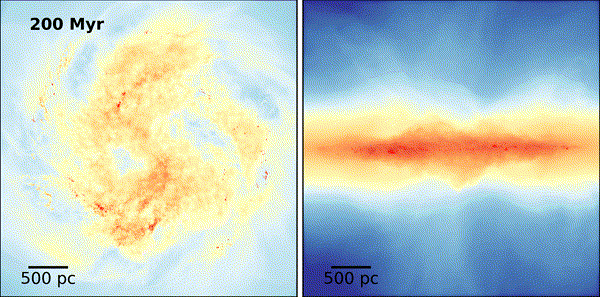Dwarf galaxies are the smallest, most numerous, and most abundant galaxies in the universe, making them an essential component of the cosmic ecosystem. Over the past decade, observations of the nearby universe have revealed a multitude of diverse and peculiar dwarf galaxies, whose formation and evolution remain one of the most enigmatic puzzles in galaxy formation. Due to their low mass and shallow gravitational potential, dwarf galaxies are extremely sensitive to stellar feedback processes. This characteristic makes them ideal targets for studying the impact of stellar feedback on the baryonic cycle in galaxies.
Recently, an international team led by Professor Hui Li from the Department of Astronomy at Tsinghua University developed a novel model called “RIGEL” to study the physical processes of the interaction between dwarf galaxies and their surrounding medium through first-principle numerical simulations. Using the RIGEL model, the team achieved a groundbreaking milestone on supercomputers by performing radiation hydrodynamics simulations of galaxies with a resolution down to the mass of the Sun. These simulations resolved the evolution of ionized hydrogen regions and supernova remnants around individual massive stars, unveiling the nonlinear effects of small-scale stellar formation physics (especially radiation feedback) on large-scale galactic outflows.
As stars form and evolve, they interact with their surrounding environment, this process is known as stellar feedback. Radiation feedback from stars, in particular, can quickly disperse the molecular clouds where stars form, thereby regulating star formation activity across the galaxy. However, since radiation propagates at the speed of light, much faster than other physical processes, radiation hydrodynamic simulations require significant computational resources, both in terms of software and hardware. For a long time, numerical simulations of galaxy formation have mostly ignored or at most used approximated methods to simulate the effects of radiation feedback.
The RIGEL model is based on the advanced adaptive mesh and first-moment method radiation magnetohydrodynamics solver Arepo-RT. It integrates the latest stellar radiation and stellar wind models with interstellar medium models, providing a powerful tool for comprehensively and efficiently studying stellar feedback and its impact on galaxy scales in various high-resolution galaxy and cosmological simulations.
Figure 1 illustrates the gas surface density distribution of an isolated dwarf galaxy simulated with the RIGEL model at 1 solar mass resolution after 900 Myr. The figure shows that the gas in the galactic disk exhibits complex structures, interspersed with high-temperature bubbles created by stellar feedback. Young star clusters (blue dots) and cold gas clouds are spatially anti-correlated, while metals diffuse outward from the regions near young stars. These phenomena demonstrate the regulation effects of stellar feedback on the structure of the interstellar medium, star formation, and baryonic cycling.

Figure 1 Face-on and edge-on view of the simulated galaxies at 900 Myr, showing the integrated gas mass surface density.
As shown in Figure 2, the left panel presents the star cluster initial mass function in the simulated dwarf galaxy, while the right panel shows the mass loading factor of the galactic outflow (i.e., the ratio of mass outflow rate to star formation rate). It can be seen that radiation feedback suppresses rapid star formation on the cluster scale, reducing the number of massive star clusters. However, on the galactic scale, radiation feedback significantly increases the mass loading factor of the outflow, indicating that stellar feedback more effectively drives gas outflows caused by galactic winds. This demonstrates the highly complex effects produced by the nonlinear combination of various stellar feedback mechanisms across different scales, which the RIGEL model comprehensively captures through detailed first-principles modeling.

Figure 2, left panel: Cluster initial mass function in the simulated dwarf galaxy. The red and green lines represent simulations of dwarf galaxies with extremely low and low metallicities, respectively, while the blue line represents the simulation without radiation feedback. Right panel: Mass loading factor (the ratio of mass outflow rate to star formation rate) in the simulated dwarf galaxy, with line colors corresponding to those in the left panel.
This work was published in Astronomy & Astrophysics and was recommended by the editor as the cover article of the journal. The first author is Yunwei Deng, a Ph.D. student from the Department of Astronomy at Tsinghua University, and the corresponding author is Assistant Professor Hui Li. Collaborators include researchers from the University of Cambridge, York University, the University of Texas at Dallas, and Columbia University. This research was supported by the Ministry of Science and Technology Key R&D Program and the National Natural Science Foundation of China.
Article link: https://doi.org/10.1051/0004-6361/202450699


